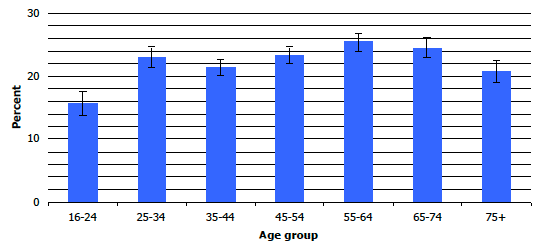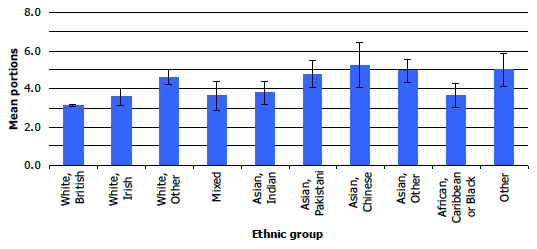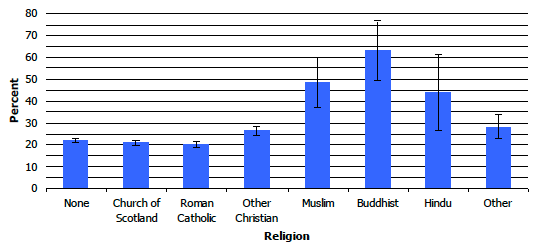Scottish Health Survey - topic report: equality groups
Topic report in the Scottish Health Survey series providing breakdowns of key health behaviours and outcomes by gender, age, ethnic group, religion, disability and sexual orientation.
This document is part of a collection
6 Diet
Summary
- Women were slightly more likely than men to eat 5 portions of fruit and vegetables a day.
- 16-24 year olds were least likely to eat 5-a-day with consumption peaking at age 55-64 before dropping slightly for older age groups.
- White British respondents were least likely to eat 5 portions of fruit and vegetables a day whilst respondents from White Other, Pakistani, Chinese, Asian Other and Other ethnic groups were all had significantly higher consumption than the national average.
- Buddhists, Muslims and Hindus were most likely to meet the 5-a-day recommendation and consumed the highest mean daily portions of fruit and vegetables.
- Fewer adults with a limiting long-term condition ate 5 portions of fruit and vegetables a day than those without a condition.
- A significantly lower proportion of those who reported their sexual orientation as 'other' and those that preferred not to answer the question ate the recommended quantities of fruit and vegetables than the national average.
6.1 Measures of diet
The Scottish Health Survey includes a module of questions on fruit and vegetable consumption which was designed to monitor the '5-a-day' policy. To determine the total number of portions that had been consumed in the 24 hours preceding the interview, the fruit and vegetable module asked about the following food types: vegetables (fresh, frozen or canned); salads; pulses; vegetables in composites (e.g. vegetable chilli); fruit (fresh, frozen or canned); dried fruit; and fruit in composites (e.g. apple pie). A portion was defined as the conventional 80g of a fruit or vegetable. As 80g is difficult to visualise, a 'portion' was described using more everyday terms, such as tablespoons, cereal bowls and slices. Examples were given in the questionnaire to aid the recall process, for instance, tablespoons of vegetables, cereal bowls full of salad, pieces of medium sized fruit (e.g. applies) or handfuls of small fruits (e.g. raspberries). In spite of this, there may be some variation between participants' interpretations of 'a portion'. These everyday measures were converted back to 80g portions prior to analysis. The following table shows the definitions of the portion sizes used for each food item included in the survey:
| Food item | Portion size |
|---|---|
| Vegetables (fresh, frozen or canned) | 3 tablespoons |
| Pulses (dried) | 3 tablespoons |
| Salad | 1 cereal bowlful |
| Vegetables in composites, such as vegetable chilli | 3 tablespoons |
| Very large fruit, such as melon | 1 average slice |
| Large fruit, such as grapefruit | Half a fruit |
| Medium fruit, such as apples | 1 fruit |
| Small fruit, such as plum | 2 fruits |
| Very small fruit, such as blackberries | 2 average handfuls |
| Dried fruit | 1 tablespoon |
| Fruit in composites, such as stewed fruit in apple pie | 3 tablespoons |
| Frozen fruit/canned fruit | 3 tablespoons |
| Fruit juice | 1 small glass (150 ml) |
Since the '5-a-day' policy stresses both volume and variety, the number of portions of fruit juice, pulses and dried fruit was capped so that no more than one portion could contribute to the total number of portions consumed. Interviewers recorded full or half portions, but nothing smaller.
Two measures are covered in this chapter: the proportion of respondents consuming the recommended 5 portions of fruit and vegetables a day; and the average portions of fruit and vegetables eaten a day.
6.2 Fruit and vegetable consumption by gender
There was a small but significant gender difference in the proportion of men and women eating 5 or more portions per day (24% of women compared with 21% of men) with a similar pattern in the mean number of portions eaten per day (women ate 3.4 portions compared to 3.1 for men).
6.3 Fruit and vegetable consumption by age
Consumption of 5-a-day was significantly associated with age. Adults aged 16-24 were least likely to eat 5 or more portions per day (16%) and ate the fewest portions per day (2.7). Consumption peaked at age 55-64 (when 25% ate 5 or more portions per day with an average of 3.5 portions) before decreasing to a level of 21%(and 3.3 portions) at age 75 and over.
Figure 6A: Proportion eating 5 or more portions of fruit and vegetables a day, by age, 2008-2011 combined

6.4 Fruit and vegetable consumption by ethnic group
There was a significant association between fruit and vegetable consumption and ethnic group. White British respondents were the least likely to eat 5-a-day (21%). Conversely, White Other (40%, 4.6 mean portions), Pakistani (48%, 4.8 mean portions), Chinese (49%, 5.2 mean portions), Asian Other (51%, 5.0 mean portions) and Other ethnic groups (46%, 5.0 mean portions) were all significantly higher than the national average (22%, 3.2 mean portions) in terms of their consumption of 5 or more portions per day.
Figure 6B: Mean daily portions of fruit and vegetables, by ethnic group, 2008-2011 combined

Previous studies have found that people with a Pakistani background are more likely to be eating fruit and vegetables in Scotland1 and in the UK generally.2 However, in the Multi-ethnic Scotland report, Pakistanis living in Glasgow were found to be less likely to eat five portions of fruit and vegetables a day.3 Studies in the USA have found more dramatic dietary differences within multi-ethnic populations.4
6.5 Fruit and vegetable consumption by religion
Buddhists (63%), Muslims (49%) and Hindus (44%) were most likely to meet the 5-a-day recommendation and consumed the highest mean daily portions (6.8, 5.1 and 4.5 portions respectively), significantly greater than the national average (22% and 3.2 portions). This is slightly more than has been reported elsewhere.5 Although Buddhism in general does not have a strict dietary code, some schools of Buddhism forbid eating meat and many Buddhists are vegetarian, which may explain the high fruit and vegetable intake. It has been suggested that religious belief may well impact on the health of the members because of the modest dietary requirements that many denominations have.6
Church of Scotland and Roman Catholic respondents ate slightly, but significantly, less portions per day than the national average (3.1 compared with 3.2) and Roman Catholics were significantly less likely to eat 5 or more portions per day than the national average (20% compared with 22%). This data corresponds with the Dimensions of Diversity report, which reported one in five Church of Scotland and Roman Catholics eating sufficient fruit and vegetables.7
Figure 6C: Proportion eating 5 or more portions of fruit and vegetables a day, by religion, 2008-2011 combined

6.6 Fruit and vegetable consumption by disability
There was some variation in diet between disability groups. Fewer adults with a limiting long-term condition (19%) ate 5 portions of fruit and vegetables a day than those without a condition (23%). On average, respondents with a limiting longstanding condition ate 3.0 portions of fruit and vegetables a day compared with 3.3 for those with a non-limiting condition and 3.4 for those with no condition.
6.7 Fruit and vegetable consumption by sexual orientation
Respondents who identified themselves as lesbian or gay were the most likely to have eaten 5 or more portions of fruit and vegetables on the day prior to interview (28%) and had the highest mean daily portions (3.7), although this wasn't significantly different from the national average (22%, 3.2 portions). A significantly lower proportion of those who reported their sexual orientation as 'other' and those that preferred not to answer the question (both 15%) ate the recommended quantities of fruit and vegetables than the national average. These two groups also ate the lowest number of daily portions on average (both 2.7).
Contact
Email: Julie Ramsay
There is a problem
Thanks for your feedback